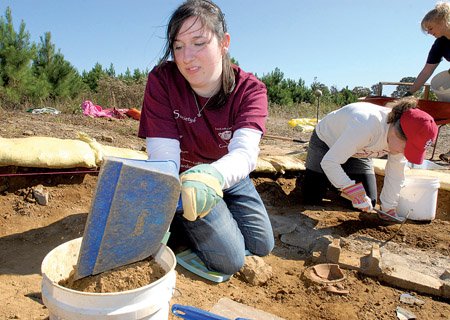THREE RIVERS AREA — Harding University may be the only university in the United States where students can practice archaeological digging in an outdoor laboratory.
The Biblical World and Archaeology course meets on campus for an hour on Wednesdays; then on Mondays the students drive to northwest White County to dig at a simulated archeological site for about three hours.
Dale Manor, professor of Bible and archaeology, teaches the course. He has participated in 16 seasons of excavation and survey work in Israel and other Middle Eastern countries. Helping to excavate one of theoldest ironsmith shops in the Mediterranean world was one of his most exciting projects, he said. Another memorable one involved a site that dated from the era of King Akhenaten, who ruled Egypt in 1350 B.C.
Manor and his wife, Sharon, built the laboratory on a White County slope that reminded him of one in northern Israel. They spent six months arranging three digging areas, each large enough for four student excavators. Each area has four layers, and each layer has hidden, inexpensive objects for the students to find. The site was ready for the spring semester of 2008, and this year’s class isthe third to use it.
The students have to dig carefully with small picks, dental tools and trowels. They also use brushes, dustpans and buckets to keep their excavations neat. They record and package each object they find.
They are about halfway through the course, and Manor, who recorded where every object was placed and knows when students miss one, is pleased with their work.
“They’re impressive in how thorough they are,” he said.
The 12 students are enjoying the course. Megan Valentine of Searcy said, “I want tobe an archaeologist, and this is a good way to get experience without going to the Middle East.”
Lauren Hackney of Searcy said, “I really enjoy getting to do what we are learning. The digging is going well, and the more we do the easier it becomes”
Fellow Searcian Alex Ritchie said, “When I dig for five minutes, I feel like I’m in the Middle East. Every [lab] day I feel that I have accomplished something. It’s really exciting, and I look forward to Mondays.”
On a recent Monday, the wind was strong and cold. Dale and Sharon Manor had coffee and tea brewing on an old stove. Sharon, who has accompanied Dale on his MiddleEastern excavation trips, was cooking a bread that she called “Bedouin bread.” She drizzled it with olive oil before serving.
Harding’s academic vice president, Larry Long, recently visited the site. He enjoyed the bread and seeing the students work.
He called the activity at the site “a really great example of a teacher’s creative ability to develop a lab to give first-hand experience (in archaeological digging) in central Arkansas. The complexity of the dig makes it a challenge.”
Monte Cox, dean of the College of Bible and Religion, has also visited the outdoor lab.
“It is a wonderful hands-on way to teach,” he said.
Dale Manor said that theidea for the Harding outdoor lab came after he conducted two summer programs in Castle Rock, Colo., for high school students who were interested in archaeology.
“I put the foundations to a building down in the ground and had the students dig for them,” he said.
That approach to teaching archaeology was such a success that Harding encouraged him to build an outdoor laboratory for his university students.
The Harding site is much more complicated than the one in Colorado - and six times bigger, Manor said.
“We’ve tried to find out if there’s another lab like it, and we haven’t found one,” Long said.
Three Rivers, Pages 119 on 10/25/2009
